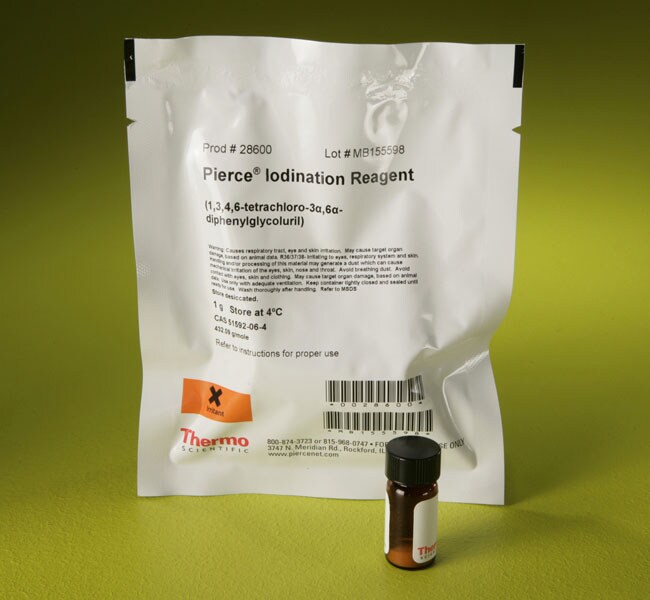
Thermo Scientific Pierce Iodination Reagent is 1,3,4,6-tetrachloro-3a,6a-diphenyl-glycoluril, an oxidizing agent that efficiently activates iodine for spontaneous incorporation into protein tyrosyl groups.
Features of Iodination Reagent:
• Extremely stable and virtually insoluble in water (Fraker and Smith, 1978)
• Solubility in chloroform permits 'plating' aliquots of the reagent on the walls of the glass or plastic iodination vessels; plated vessels can be prepared in advance and stored in a dessicator
• Allows rapid iodination of proteins in an aqueous reaction mixture containing radioactive Na125I
• Side reactions are negligible
• No reducing reagent is required, because reactions are terminated by simply decanting the reaction solution away from the plated IODO-GEN Iodination Reagent
• Specific activities of 1 x 105 cpm of 125I per microgram of protein and labeling efficiencies of 60% are easily achieved
• Can be used to iodinate phenolic groups on crosslinkers or other protein modification reagents either before, or after, a protein, peptide or cell surface is reacted with the modification reagent
• Small amounts of protein can be iodinated (Tolan, et al., 1980)
• More efficient than Chloramine-T or Lactoperoxidase (Salacinski, 1981)
• Iodinate phenolic groups on crosslinking reagents (see list of compatible reagents)
Unlike chloramine-T, Pierce Iodination Reagent can be coated on glassware to enable solid-phase oxidative activation and iodine-labeling. As a result, reducing agents are not necessary in the procedure.
Applications:
• Recommended for use with 125Iodine (Millar and Smith, 1983)
• Substitutes effectively for the highly toxic TlCl3 for nucleic acid iodination (Piatyszek, et al. 1988)
• Oxidatively remove sulfhydryl groups from solution prior to protein assay (McClard, 1981)
Iodination involves the introduction of radioactive iodine (I-125 or I-131) into certain amino acids (usually tyrosines) in proteins and peptides. Iodination takes place at the positions ortho to the hydroxyl group on tyrosine; mono- or di-substitution can occur. When iodinatable sites such as tyrosines are absent or of limited accessibility in a protein, iodinatable phenolic sites can be introduced by using the Bolton-Hunter Reagents (SHPP and Sulfo-SHPP). Certain crosslinkers also contain iodinatable tyrosyl groups in their spacer arms.
Radioactive 125-I or 131-I can be incorporated into proteins either by enzymatic or chemical oxidation. In the chemical oxidation method, sodium iodide is converted to its corresponding reactive iodine form, which then spontaneously incorporates into tyrosyl groups. While necessary for iodine activation, oxidizing reagents are potentially damaging to proteins. Pierce Iodination Reagent (previously known as IODO-GEN Reagent) is milder than chloramine-T, yet equally effective for iodine activation. Using the reagent in a solid-phase procedure makes iodination even more gentle on proteins.
| Code | Description |
|---|---|
| 28600 | Catalog Number: 28600 |

